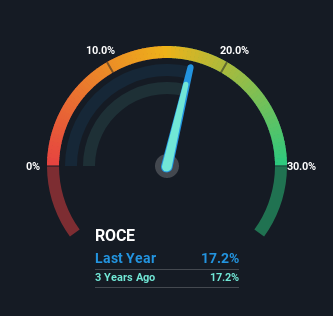- United States
- /
- Hospitality
- /
- NYSE:SIX
Six Flags Entertainment (NYSE:SIX) Could Be Struggling To Allocate Capital
What financial metrics can indicate to us that a company is maturing or even in decline? A business that's potentially in decline often shows two trends, a return on capital employed (ROCE) that's declining, and a base of capital employed that's also declining. Basically the company is earning less on its investments and it is also reducing its total assets. So after glancing at the trends within Six Flags Entertainment (NYSE:SIX), we weren't too hopeful.
Return On Capital Employed (ROCE): What Is It?
For those who don't know, ROCE is a measure of a company's yearly pre-tax profit (its return), relative to the capital employed in the business. The formula for this calculation on Six Flags Entertainment is:
Return on Capital Employed = Earnings Before Interest and Tax (EBIT) ÷ (Total Assets - Current Liabilities)
0.17 = US$385m ÷ (US$2.7b - US$434m) (Based on the trailing twelve months to January 2023).
So, Six Flags Entertainment has an ROCE of 17%. On its own, that's a standard return, however it's much better than the 10% generated by the Hospitality industry.
See our latest analysis for Six Flags Entertainment

In the above chart we have measured Six Flags Entertainment's prior ROCE against its prior performance, but the future is arguably more important. If you'd like to see what analysts are forecasting going forward, you should check out our free report for Six Flags Entertainment.
What Can We Tell From Six Flags Entertainment's ROCE Trend?
We are a bit worried about the trend of returns on capital at Six Flags Entertainment. Unfortunately the returns on capital have diminished from the 22% that they were earning five years ago. Meanwhile, capital employed in the business has stayed roughly the flat over the period. Since returns are falling and the business has the same amount of assets employed, this can suggest it's a mature business that hasn't had much growth in the last five years. If these trends continue, we wouldn't expect Six Flags Entertainment to turn into a multi-bagger.
The Key Takeaway
In summary, it's unfortunate that Six Flags Entertainment is generating lower returns from the same amount of capital. Investors haven't taken kindly to these developments, since the stock has declined 51% from where it was five years ago. Unless there is a shift to a more positive trajectory in these metrics, we would look elsewhere.
One more thing to note, we've identified 2 warning signs with Six Flags Entertainment and understanding these should be part of your investment process.
While Six Flags Entertainment isn't earning the highest return, check out this free list of companies that are earning high returns on equity with solid balance sheets.
New: Manage All Your Stock Portfolios in One Place
We've created the ultimate portfolio companion for stock investors, and it's free.
• Connect an unlimited number of Portfolios and see your total in one currency
• Be alerted to new Warning Signs or Risks via email or mobile
• Track the Fair Value of your stocks
Have feedback on this article? Concerned about the content? Get in touch with us directly. Alternatively, email editorial-team (at) simplywallst.com.
This article by Simply Wall St is general in nature. We provide commentary based on historical data and analyst forecasts only using an unbiased methodology and our articles are not intended to be financial advice. It does not constitute a recommendation to buy or sell any stock, and does not take account of your objectives, or your financial situation. We aim to bring you long-term focused analysis driven by fundamental data. Note that our analysis may not factor in the latest price-sensitive company announcements or qualitative material. Simply Wall St has no position in any stocks mentioned.
About NYSE:SIX
Six Flags Entertainment
Owns and operates regional theme and waterparks under the Six Flags name.
Moderate growth potential and slightly overvalued.
Similar Companies
Market Insights
Community Narratives



